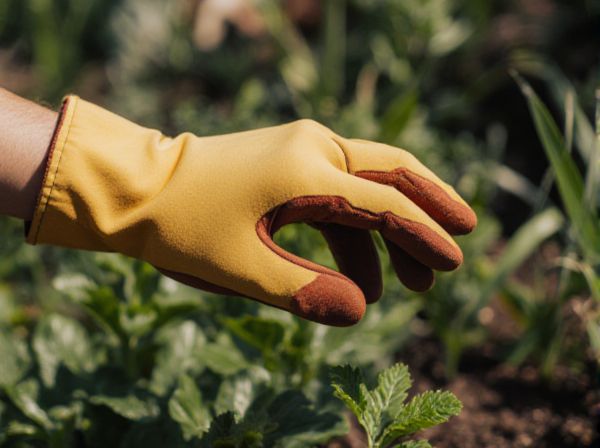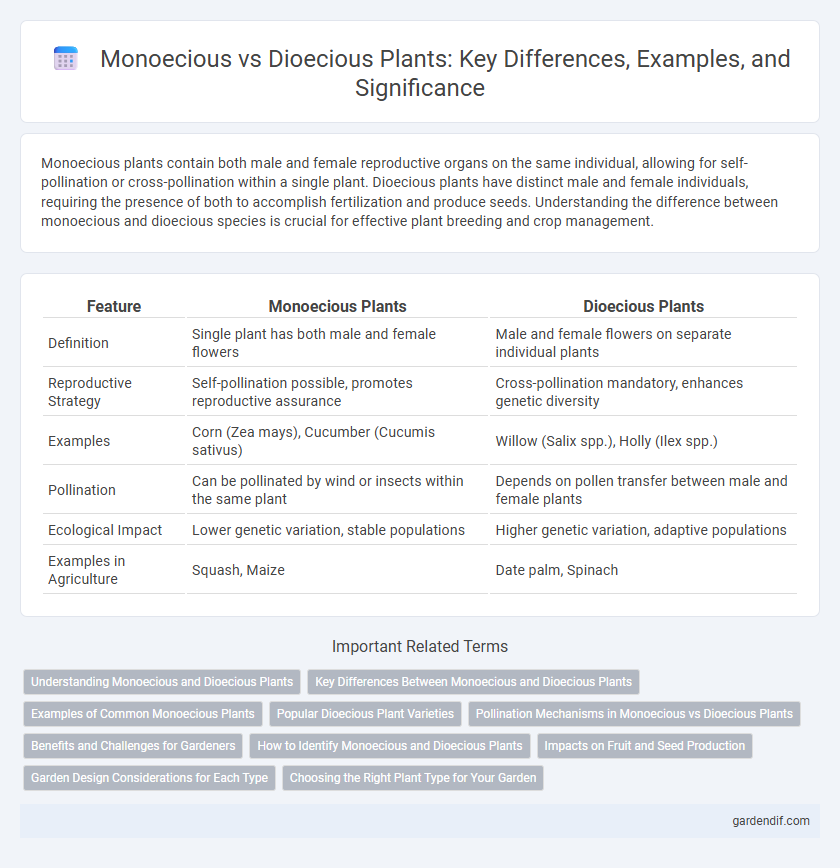
Monoecious vs Dioecious Illustration
Monoecious plants contain both male and female reproductive organs on the same individual, allowing for self-pollination or cross-pollination within a single plant. Dioecious plants have distinct male and female individuals, requiring the presence of both to accomplish fertilization and produce seeds. Understanding the difference between monoecious and dioecious species is crucial for effective plant breeding and crop management.
Table of Comparison
| Feature | Monoecious Plants | Dioecious Plants |
|---|---|---|
| Definition | Single plant has both male and female flowers | Male and female flowers on separate individual plants |
| Reproductive Strategy | Self-pollination possible, promotes reproductive assurance | Cross-pollination mandatory, enhances genetic diversity |
| Examples | Corn (Zea mays), Cucumber (Cucumis sativus) | Willow (Salix spp.), Holly (Ilex spp.) |
| Pollination | Can be pollinated by wind or insects within the same plant | Depends on pollen transfer between male and female plants |
| Ecological Impact | Lower genetic variation, stable populations | Higher genetic variation, adaptive populations |
| Examples in Agriculture | Squash, Maize | Date palm, Spinach |
Understanding Monoecious and Dioecious Plants
Monoecious plants bear both male and female flowers on the same individual, enabling self-pollination, as seen in corn and cucumbers. Dioecious plants have distinct male and female individuals, requiring cross-pollination between separate plants, exemplified by holly and willow species. Understanding these reproductive strategies is crucial for effective plant breeding and cultivation practices.
Key Differences Between Monoecious and Dioecious Plants
Monoecious plants have both male and female reproductive organs on the same individual, allowing for self-pollination, while dioecious plants possess separate male and female individuals, requiring cross-pollination for reproduction. In monoecious species, such as corn and cucumbers, flowers can be unisexual but coexist on a single plant, enhancing reproductive efficiency. Dioecious plants, like holly and willow, maintain genetic diversity through obligatory outcrossing between distinct male and female plants.
Examples of Common Monoecious Plants
Corn (Zea mays) and cucumbers (Cucumis sativus) are classic examples of common monoecious plants, bearing separate male and female flowers on the same individual. Squash (Cucurbita spp.) and oak trees (Quercus spp.) also exhibit monoecious characteristics, facilitating efficient pollination within a single plant. This reproductive strategy enhances genetic diversity and fruit production without relying on the presence of a separate sex.
Popular Dioecious Plant Varieties
Dioecious plants, characterized by having separate male and female individuals, include popular varieties such as holly (Ilex), kiwi (Actinidia deliciosa), and asparagus (Asparagus officinalis). Unlike monoecious plants that bear both male and female flowers on the same specimen, dioecious species require cross-pollination between male and female plants to produce fruit and seeds. Understanding dioecious plant cultivation is essential for gardeners and farmers aiming to ensure successful pollination and optimal yield.
Pollination Mechanisms in Monoecious vs Dioecious Plants
Monoecious plants contain both male and female flowers on the same individual, facilitating self-pollination and reducing dependence on external pollinators. Dioecious plants have separate male and female individuals, requiring cross-pollination through agents like wind, insects, or animals to ensure fertilization. This fundamental difference impacts genetic diversity and pollination strategies within plant populations.
Benefits and Challenges for Gardeners
Monoecious plants bear both male and female flowers on the same individual, facilitating self-pollination and enhancing fruit production in limited garden spaces. Dioecious plants have distinct male and female individuals, promoting genetic diversity and often resulting in healthier offspring but requiring careful planning to ensure both sexes are present for pollination. Gardeners must balance the ease of monoecious plants with the biodiversity benefits of dioecious species when designing productive and sustainable gardens.
How to Identify Monoecious and Dioecious Plants
Monoecious plants bear both male and female flowers on the same individual, making it possible to identify them by observing separate staminate (male) and pistillate (female) flowers present on one plant. Dioecious plants have distinct male and female individuals, identifiable by flowers containing exclusively either stamens or pistils on separate plants. Examining flower structure, arrangement, and the distribution of reproductive organs helps distinguish monoecious species like corn from dioecious species such as holly.
Impacts on Fruit and Seed Production
Monoecious plants, with both male and female flowers on the same individual, facilitate higher fruit and seed production through self-pollination, increasing reproductive efficiency. Dioecious plants require cross-pollination between separate male and female individuals, often resulting in genetic diversity but potentially limiting fruit yield due to dependence on pollinator activity and population sex ratios. This reproductive strategy directly impacts agricultural productivity and seed dispersal dynamics in plant populations.
Garden Design Considerations for Each Type
Monoecious plants, bearing both male and female flowers on the same individual, simplify garden design by requiring fewer plants to achieve pollination and fruit set, making them ideal for limited space. Dioecious plants, with distinct male and female individuals, demand careful planning to ensure proximity of both sexes for successful reproduction, affecting plant placement and overall garden layout. Selecting monoecious species can reduce maintenance and ensure consistent yields, while dioecious species may offer greater genetic diversity and aesthetic variation when designed thoughtfully.
Choosing the Right Plant Type for Your Garden
Selecting monoecious plants offers the advantage of having both male and female flowers on the same individual, ensuring better self-pollination and higher fruit yield in limited garden spaces. Dioecious plants, with separate male and female individuals, require careful placement to guarantee effective pollination, often benefiting larger gardens where space permits diverse planting. Understanding the reproductive biology of monoecious versus dioecious species aids gardeners in optimizing plant arrangement for successful fruit production and biodiversity enhancement.
Monoecious vs Dioecious Infographic

 gardendif.com
gardendif.com